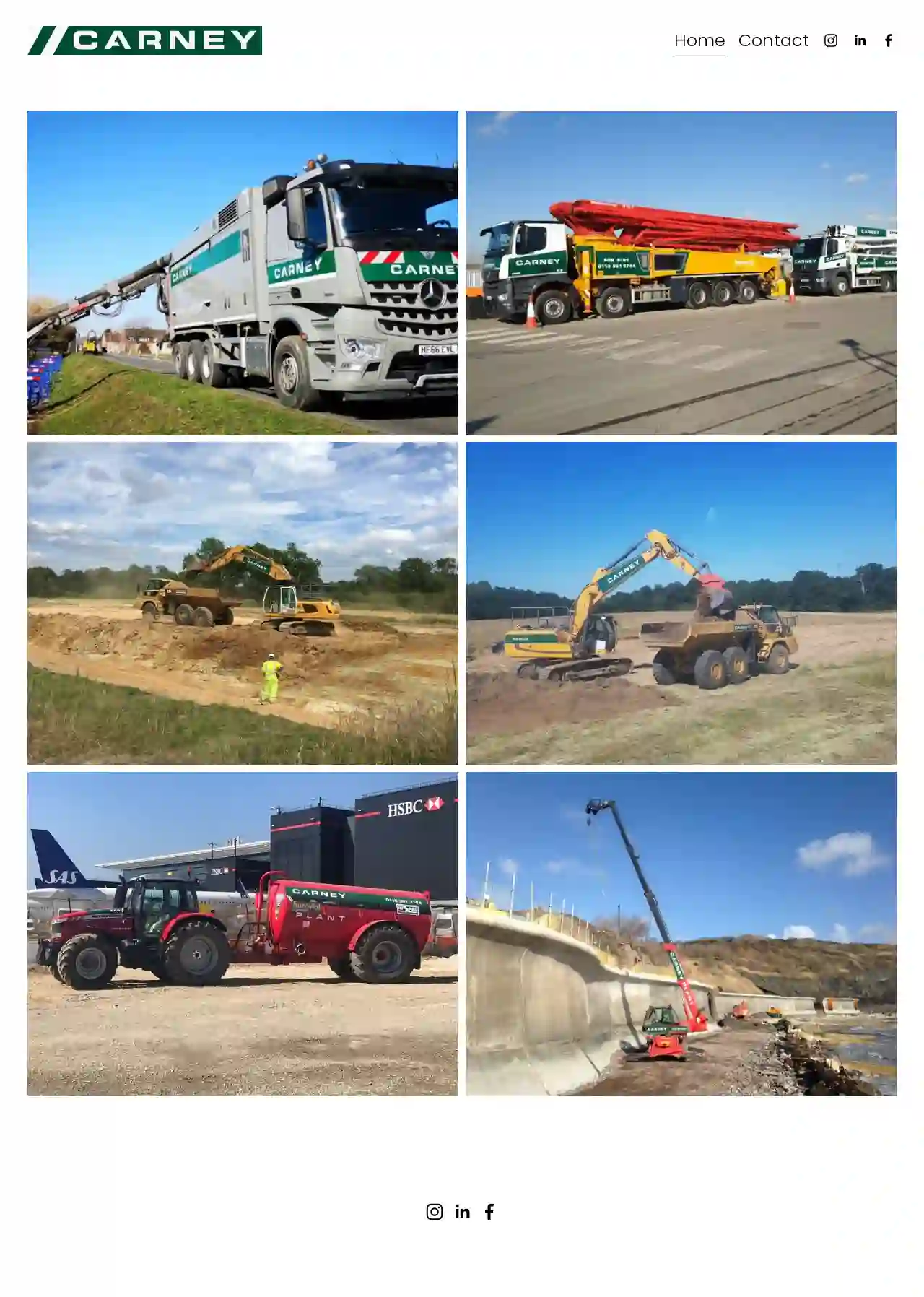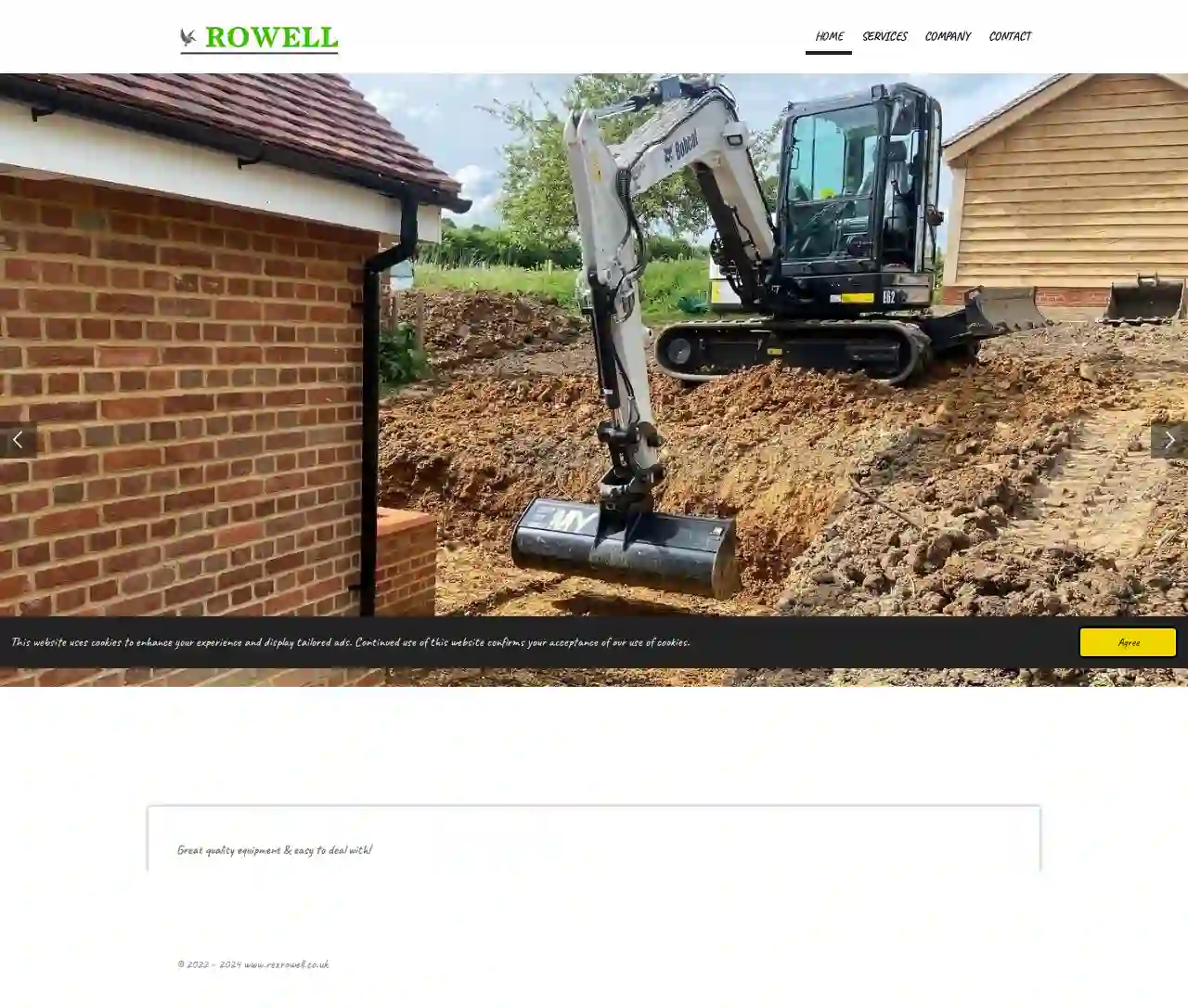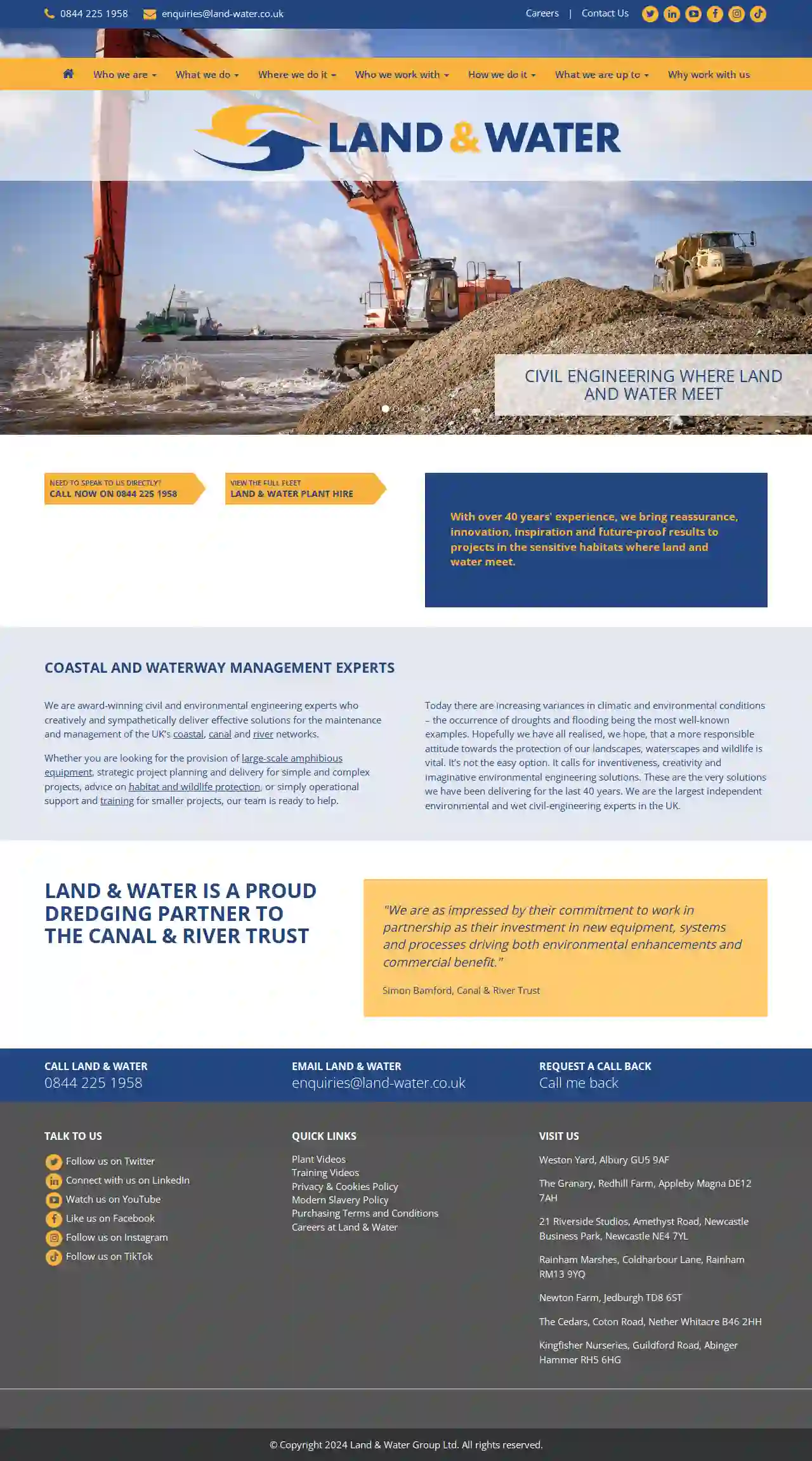Excavation Contractors Bray
Top Trenching Services in Bray
Get 3 FREE Excavation Contractors Near Me quotes for your project today! Compare profiles, reviews, accreditations, portfolio, etc... and choose the best deal.

Carney Plant
Reading, GBCarney Plant: Your Trusted Partner for Construction Equipment Carney Plant is a leading provider of construction equipment and services in the UK. We offer a wide range of equipment, including suction excavators, concrete pumps, tracked excavators, articulated dump trucks, tractors, and rotational telehandlers. Our team of experienced professionals is dedicated to providing our clients with the highest quality equipment and services. We are committed to safety, reliability, and customer satisfaction. Whether you're a large construction company or a small homeowner, we have the equipment and expertise to meet your needs. We offer competitive rates and flexible rental options to suit your budget. Contact us today to learn more about our services and how we can help you get the job done right.
- Services
- Why Us?
- Gallery
Get Quote
Rex Rowell Groundworks
57 reviewsAldershot, GBPutting Safety First Home Safe Every Day Established in 2016, Rex Rowell is a fully insured groundwork and plant hire company operating throughout Surrey and Hampshire. We are committed to providing a professional and reliable service, with a focus on safety and quality. Our team of experienced operators and skilled groundworkers are dedicated to delivering exceptional results on every project. We offer a wide range of services, including: Plant Hire Operator & Excavator Hire Trial Hole Digging Soak Away Test Pitts Foundations Ditching Archaeological Digging Groundwork Site Clearance Bulk Excavation Ponds & River Banks Soak Away Instillation Drainage Treatment plants Construction Car Parks Retaining Walls & Structures Roads & Tracks Driveways Concrete Slabs We are fully insured to £5 million and are CPCS & CSCS compliant. We are also proud to be a member of the Construction Industry Scheme (CIS). Our commitment to safety is paramount. We have a comprehensive health and safety policy in place and all our operators are fully trained and qualified. We are also committed to environmental sustainability and strive to minimize our impact on the environment. We are confident that we can provide you with the highest quality service and workmanship. Contact us today to discuss your project requirements.
- Services
- Why Us?
- Testimonials
- Gallery
Get Quote
Reading groundworks paving contractors
4.69 reviewsReading, GBAbout Reading Groundworks Reading Groundworks is a family-run business specializing in paving and bespoke garden builds. We have years of experience and know the best methods to create the perfect end result for your project. We undertake all jobs to the highest standard and have all the correct machines to get the job completed safely and properly. We work with you to create the perfect solution for your project. Whatever your intention, we will always provide the best possible solution at great rates. We thrive off our referrals from our satisfied clients. Get in touch for free advice and quotes today - we can help you with any project big or small. We are proud to be a family-run business with a professional service and all work guaranteed. Our aim is your referral. We have many satisfied customers and are happy to provide testimonials and photos of recent projects we have completed. Our aim is to always create the perfect end result and we will turn your thoughts into a fantastic space for you and your family. Reading Groundworks Contractors knows that landscaping is more than planting flowers. We work with our clients to craft the perfect spaces for their needs.
- Services
- Why Us?
- Gallery
Get Quote
Guildford Landscapes Ltd
4.935 reviews7 Burnt hill, Plaistow Road, Godalming, GU8 4PG, GBGuildford Landscapes Ltd We are a family-run business with over 20 years of experience in the landscaping and paving industry. We are committed to providing our clients with the highest quality workmanship and customer service. We offer a wide range of services to meet your needs, from simple garden maintenance to complete landscaping projects. We are also proud to be approved members of the following associations: Our Services We offer a wide range of services to meet your needs, from simple garden maintenance to complete landscaping projects. We are also proud to be approved members of the following associations: Paving Driveways Patios Fencing Decking Groundworks Gravel Drives Tarmac Driveways Paths Block Paving Turfing & Lawns Indian Sandstone
- Services
- Why Us?
- Testimonials
- Gallery
Get Quote
Wroxton Ltd
11 reviewsUnit 16, Redfields Business Park, Church Crookham, Fleet, GU52 0RD, GBPrestigious Landscape Design From design, to build, through to maintenance, we can create your perfect garden. Quality Fencing Installation We offer all types of fencing, from standard timber close board to fancy metal railings and security and environmental fencing. Show Gardens We've been installing luxury garden designs in show houses for commercial clients for over 20 years. Residential Projects Free consultation and no obligation quote, Wroxton produce high quality private gardens. Commercial Contracts Working to tight deadlines producing speedy and efficient work, Wroxton are the number one choice for a number of leading UK house builders. Public Open Spaces Our plant, machinery and experience make us an easy choice for large scale projects. Plant and Machinery Services We supply a large range of plant and machinery – available to hire out with a driver. Here at Wroxton we offer a diverse range of external services. We have over 25 years experience in the landscaping business and pride ourselves in our attention to detail, unique design ideas and our dedication to client satisfaction. Based in Berkshire & Hampshire, but working all over the south, we work on both commercial and residential projects ranging from £500 to over £1 million. Employing over 40 hardworking individuals, we are able to take on large scale contracts, and with our expert management systems able to provide extremely fast response times which offer our clients first class service – this can be invaluable given the biggest demand for new build developments in decades. At Wroxton we avoid sub-contracting, hence are able to control the cost and quality of our work and so deliver an expert service whenever called upon. Our services include: Hard and Soft Landscaping Tree Services Metal, Timber, Agricultural & Security Fencing Plant Hire Maintenance Groundworks In addition, Wroxton Group provides and owns all its plant and machinery. As a result we can provide the most cost effective and competitive prices for our contracts, working closely with many of the UK’s leading housing developers – hence for many we are the number one choice! Our Key Services LANDSCAPING PLANT FENCING DESIGN Why Choose Us Because...we have years of experience, and constantly strive to maintain an excellent, efficient service all round. If you’re choosing us you already know you’re going with a reputable company that will always go that extra mile to satisfy our customers. And because...with all our own plant and machinery, and great supply contacts within the construction industry, we can guarantee the most competitive quotes. With over 40 employees we can offer great lead times to get the job finished as soon as possible.
- Services
- Why Us?
- Testimonials
- Gallery
Get Quote
J Searle Contractors Ltd
51 reviewsThe Pines, Green Lane East, Guildford, GU3 2JL, GBWelcome To J Searle Contractors Ltd J Searle Contractors are a leading groundworks company, offering a comprehensive range of services to both domestic and commercial clients across the South-East regions. We have been delivering our services across the South-East for over 3 generations. Professional Groundwork Specialists At J Searle Contractors Ltd, we take pride in being a leading provider of comprehensive groundwork services tailored to meet the diverse needs of our clients. With a rich legacy of expertise and commitment, we offer a range of groundwork solutions, ensuring precision, safety, and environmental responsibility during every project. Our Services J.Searle Contractors take pride in our reputation as being a reliable and trustworthy groundworks company with a focus on health and safety and environmental responsibility. We have been delivering our services across the South-East for over 3 generations.
- Services
- Why Us?
- Gallery
Get Quote
DFP Construction Ltd
52 reviews2a Woods Rd, Caversham, Reading, RG4 6NA, GBDOMESTIC AND COMMERCIAL Groundwork Contractors based in Reading covering London and the South DFP Construction Group is a well respected groundwork contractor company covering all aspects of ground work from small dwellings and single buildings to large developments. We also cover areas such as Berkshire, Surrey, Oxfordshire and Hampshire. Get in contact with us for your project. COMPREHENSIVE GROUNDWORK & BUILDING RENOVATION CPCS QUALIFIED EXTENSIVE GROUNDWORK & DEMOLITION SERVICES "CONSTRUCTION SERVICES FOR YOUR PROJECT" Groundwork Civil Engineering Demolition Earth Removal Swimming Pool Excavation When it comes to finding comprehensive groundwork or civil engineering services for your next project, you need the professional team at DFP Construction Group. With over 22 years' experience in the trade, we cover everything from groundwork and drainage systems to driveways and demolition services. Whatever the scale of the project, either domestic or commercial, you can rely on us to complete it on time. We are known for high quality workmanship and our professionals are CPCS qualified. YOU CAN RELY ON US GROUNDWORK CONTRACTOR CIVIL ENGINEERING DRAINAGE DEMOLITION SERVICES Our services include: Foundations Drainage Steel & concrete reinforcements Block paving Demolition services Site clearance Groundworks Contractor Civil engineering and groundwork :We are known for exceptional construction services. With decades of experience, DFP Construction Group is well-known for its high quality of work, professionalism and punctuality. We take pride in our health and safety with all our teams CPCS qualified. Civil Engineering Site clearances and excavation DPF Construction Group provides an extensive range of groundwork services to domestic and commercial customers, from the installation of house foundations and drainage systems to block paving and driveways. We appointed DFP Construction to carry out the groundworks and external works of a recently completed renovation and extension in the Reading area. As with all projects, this one had its own unique challenges, including close proximity to neighbours and limited space to operate. Both Dorot and Floret managed these challenges professionally and went above and beyond to help resolve any problems as quickly as possible. DFP Construction were a pleasure to work with and we were very pleased with their standard of work. We would highly recommend them.
- Services
- Why Us?
- Testimonials
- Gallery
Get Quote
Land & Water Services Ltd
3.911 reviewsRainham Marshes, Coldharbour Lane, Rainham, RM13 9YQ, GBAward-winning civil and environmental engineering experts With over 40 years' experience, we bring reassurance, innovation, inspiration and future-proof results to projects in the sensitive habitats where land and water meet. We are award-winning civil and environmental engineering experts who creatively and sympathetically deliver effective solutions for the maintenance and management of the UK’s coastal, canal and river networks. Whether you are looking for the provision of large-scale amphibious equipment, strategic project planning and delivery for simple and complex projects, advice on habitat and wildlife protection, or simply operational support and training for smaller projects, our team is ready to help. Today there are increasing variances in climatic and environmental conditions – the occurrence of droughts and flooding being the most well-known examples. Hopefully we have all realised, we hope, that a more responsible attitude towards the protection of our landscapes, waterscapes and wildlife is vital. It’s not the easy option. It calls for inventiveness, creativity and imaginative environmental engineering solutions. These are the very solutions we have been delivering for the last 40 years. We are the largest independent environmental and wet civil-engineering experts in the UK. Land & Water is a proud dredging partner to the Canal & River Trust "We are as impressed by their commitment to work in partnership as their investment in new equipment, systems and processes driving both environmental enhancements and commercial benefit." Simon Bamford, Canal & River Trust
- Services
- Why Us?
- Testimonials
- Gallery
Get Quote
Wildtrak Group
21 Peartree Road, Ashford Middlesex, Ashford, GBWelcome to Wildtrak Group The Wildtrak Group is a national service provider consisting of three key sectors: Plant Hire, Ground Maintenance and Groundworks. Offering a professional and affordable service across all sectors within the business. Our aim is simple, provide the best quality service to all of our clients, commercial or residential our expectation is to be the best. We are here to help so contact us today
- Services
- Why Us?
- Gallery
Get Quote
Angus River Earthworks Inc
52 reviewsVernon, GBAngus River Earthworks: Your Trusted Excavation Partner in Vernon, BC Angus River Earthworks is a leading excavation contractor serving both residential and commercial property owners in Vernon, British Columbia. We are committed to providing exceptional service and delivering high-quality results on every project. Our team of skilled professionals utilizes state-of-the-art equipment and adheres to the highest safety standards, ensuring your project is completed efficiently and to your satisfaction. Our Expertise From initial site grading to complete site development, we handle all aspects of your project with precision and care. We specialize in a wide range of services, including: Earthworks Excavation Septic Systems Retaining Walls Grading Underground Utilities Why Choose Angus River Earthworks? We understand that your project is important to you, and we are dedicated to exceeding your expectations. Here's what sets us apart: Experienced and Reliable Team Commitment to Quality and Safety Competitive Pricing Exceptional Customer Service Contact Us Today For a free estimate or to discuss your project needs, please contact us at (250) 309-4666 or email us at [email protected]. We look forward to hearing from you!
- Services
- Why Us?
- Gallery
Get Quote
Over 13,059+ Excavation Contractors in our network
Our excavation pros operate in Bray and surroundings!
ExcavationHQ has curated and vetted Top Excavation Contractors in Bray. Find a trustworthy contractor today.
Frequently Asked Questions About Excavation Contractors
- Utility Locates: Contact your utility companies to mark the locations of underground lines before excavation begins. This is usually a free service.
- Hand Digging: Excavate carefully by hand near marked utility lines to avoid damage.
- Potholing: Digging small test holes to expose and verify utility depths and locations.
- Safe Distances: Maintaining a safe distance between excavation equipment and marked utility lines.
- Vacuum Excavation: Using vacuum excavation techniques to expose utilities without digging, reducing the risk of damage.
- Planning and Surveying: Defining the excavation area, marking utility lines, and determining the required depth and grade.
- Site Preparation: Clearing vegetation, removing obstacles, and ensuring site accessibility.
- Excavation: Using appropriate equipment (excavators, backhoes, etc.) to remove earth and create the desired excavation.
- Hauling and Disposal: Transporting excavated material to designated disposal sites, complying with environmental regulations.
- Backfilling and Compaction: Refilling the excavation with suitable material and compacting it to achieve the required density and stability.
- Grading and Finishing: Leveling and shaping the surface to the final grade for landscaping or construction.
- Trench Collapses: Unstable trench walls can cave in, posing a severe risk to workers. Proper shoring and sloping are crucial safety measures.
- Utility Damage: Striking underground utilities (gas, water, electric) can cause leaks, explosions, or electrocution. Accurate utility locates and careful digging are essential.
- Falling Objects: Materials or equipment falling into excavations can injure workers. Securing work areas and using appropriate safety gear is vital.
- Equipment Accidents: Operating heavy machinery involves risks of rollovers, collisions, or mechanical failures. Trained operators and proper equipment maintenance are critical.
- Environmental Hazards: Excavated soil might contain hazardous materials (asbestos, lead). Proper testing and disposal procedures are necessary.
- New Construction: Laying foundations, basements, or underground utilities for new buildings.
- Home Additions: Creating space for new rooms, basements, or extensions.
- Landscaping: Leveling ground, creating slopes, installing retaining walls, or digging for ponds or pools.
- Drainage Improvement: Installing French drains, drainage ditches, or swales to manage water runoff.
- Utility Installation or Repair: Laying new water, sewer, gas, or electrical lines, or repairing existing ones.
- Demolition: Clearing debris and preparing the site after demolishing a structure.
How do you protect utilities during excavation?
What is the excavation process?
What are the risks associated with excavation?
How do I know if I need excavation for my project?
How do you protect utilities during excavation?
- Utility Locates: Contact your utility companies to mark the locations of underground lines before excavation begins. This is usually a free service.
- Hand Digging: Excavate carefully by hand near marked utility lines to avoid damage.
- Potholing: Digging small test holes to expose and verify utility depths and locations.
- Safe Distances: Maintaining a safe distance between excavation equipment and marked utility lines.
- Vacuum Excavation: Using vacuum excavation techniques to expose utilities without digging, reducing the risk of damage.
What is the excavation process?
- Planning and Surveying: Defining the excavation area, marking utility lines, and determining the required depth and grade.
- Site Preparation: Clearing vegetation, removing obstacles, and ensuring site accessibility.
- Excavation: Using appropriate equipment (excavators, backhoes, etc.) to remove earth and create the desired excavation.
- Hauling and Disposal: Transporting excavated material to designated disposal sites, complying with environmental regulations.
- Backfilling and Compaction: Refilling the excavation with suitable material and compacting it to achieve the required density and stability.
- Grading and Finishing: Leveling and shaping the surface to the final grade for landscaping or construction.
What are the risks associated with excavation?
- Trench Collapses: Unstable trench walls can cave in, posing a severe risk to workers. Proper shoring and sloping are crucial safety measures.
- Utility Damage: Striking underground utilities (gas, water, electric) can cause leaks, explosions, or electrocution. Accurate utility locates and careful digging are essential.
- Falling Objects: Materials or equipment falling into excavations can injure workers. Securing work areas and using appropriate safety gear is vital.
- Equipment Accidents: Operating heavy machinery involves risks of rollovers, collisions, or mechanical failures. Trained operators and proper equipment maintenance are critical.
- Environmental Hazards: Excavated soil might contain hazardous materials (asbestos, lead). Proper testing and disposal procedures are necessary.
How do I know if I need excavation for my project?
- New Construction: Laying foundations, basements, or underground utilities for new buildings.
- Home Additions: Creating space for new rooms, basements, or extensions.
- Landscaping: Leveling ground, creating slopes, installing retaining walls, or digging for ponds or pools.
- Drainage Improvement: Installing French drains, drainage ditches, or swales to manage water runoff.
- Utility Installation or Repair: Laying new water, sewer, gas, or electrical lines, or repairing existing ones.
- Demolition: Clearing debris and preparing the site after demolishing a structure.